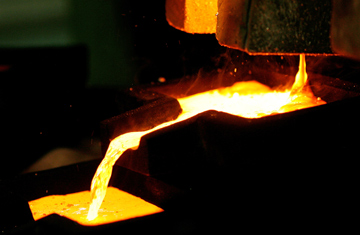
Mixed gold and silver are poured into ingot molds at a furnace facility
(2 of 2)
Cary Pinkowski, CEO of Astur Gold, which has acquired the rights to the Tapia de Casariego mine, frequently hears the same question. The proposed mine there, which would be built outside of town in what he says is the "the largest, highest quality" gold deposit in Europe, would create an estimated 850 jobs during construction and another 500 during the life of the mine. "We've already received 3,000 résumés," Pinkowski says. "Sometimes we get 50 in a single day."
But not everyone is enthusiastic. For one thing, those jobs are not sustainable, says Tapia Mayor Manuel Jesús González, who was elected in May on a platform that included opposition to the mine. "They're not producing anything, they're extracting something. So what happens when the mine runs out and the company takes its money and goes home?" he asks. "I understand that people here need work, but the mine is a short-term solution. My job is to look at the long-term impact."
He also worries that the mine will injure the two industries — dairy farming and tourism — that Tapia depends on now. An earlier mining project, proposed by a different company, was rejected by the Asturian regional government because it would have been open pit, a cheaper means of extraction that destroys a landscape. But even Astur Gold's planned underground mine would cause environmental and economic damage, says González. "What if leaching from the mine ruins our land? We won't be able to raise livestock anymore. And no one wants to spend the summer in an industrial zone."
Both Salamis and Pinkowski counter that modern techniques and regulations prevent the sort of devastation produced by mining in earlier decades. But environmental groups share González's concerns. In Galicia, the organization Verdegaia is mounting a legal challenge to the Corcoesto project, which would combine open-pit and underground mining, "We're concerned about the damage to flora and fauna," says Nela Abella, spokeswoman for Verdegaia. "But what we're most worried about is water. Gold mines use cyanide in processing. We could have cyanide in the water table."
In Tapia, where most every blank public surface these days contains competing graffiti ("Oro No!" "Oro Si!"), the conflict between environment and economy is splitting the town. Local interest groups keep tabs on one another's Facebook followers, and Astur Gold went so far as to contract a polling company to conduct an opinion survey. It found, perhaps not surprisingly considering who commissioned it, that 74% of residents supported the mine. "We haven't had actual conflict yet," says Mayor González. "But yes, it's definitely undermining harmony here."
Magdalena Gómez laments the divisions the debate is creating. But as the daughter and granddaughter of miners, she still believes the mine is worth fighting for. "It's true that a few years ago there wouldn't have been so much support for the mine," she says. "But now it's our only chance."
